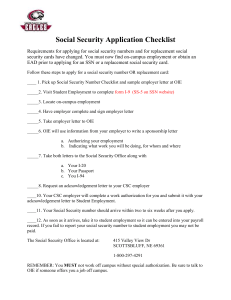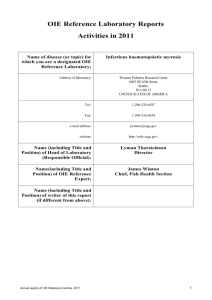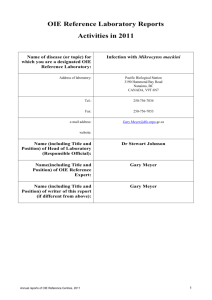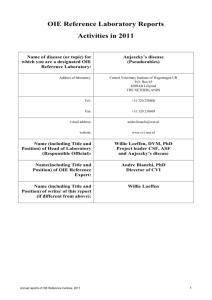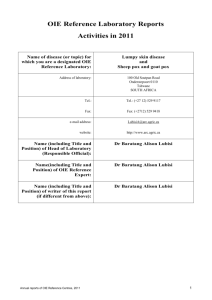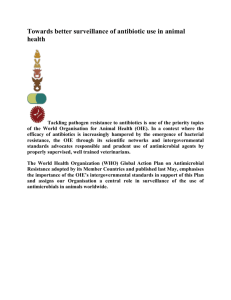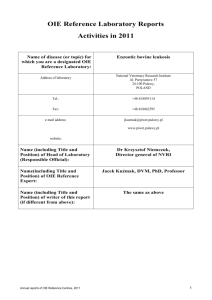Western blot (Immunoblot)
advertisement
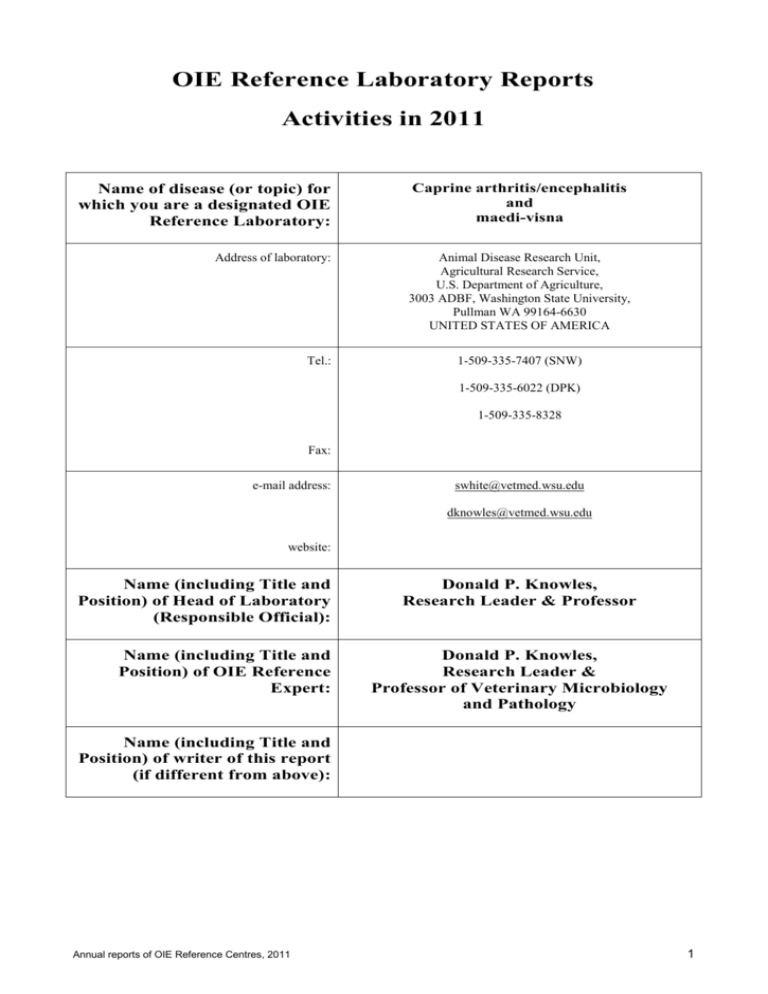
OIE Reference Laboratory Reports Activities in 2011 Name of disease (or topic) for which you are a designated OIE Reference Laboratory: Caprine arthritis/encephalitis and maedi-visna Address of laboratory: Animal Disease Research Unit, Agricultural Research Service, U.S. Department of Agriculture, 3003 ADBF, Washington State University, Pullman WA 99164-6630 UNITED STATES OF AMERICA Tel.: 1-509-335-7407 (SNW) 1-509-335-6022 (DPK) 1-509-335-8328 Fax: e-mail address: swhite@vetmed.wsu.edu dknowles@vetmed.wsu.edu website: Name (including Title and Position) of Head of Laboratory (Responsible Official): Name (including Title and Position) of OIE Reference Expert: Donald P. Knowles, Research Leader & Professor Donald P. Knowles, Research Leader & Professor of Veterinary Microbiology and Pathology Name (including Title and Position) of writer of this report (if different from above): Annual reports of OIE Reference Centres, 2011 1 Caprine arthritis/encephalitis & maedi-visna Part I: Summary of general activities related to the disease 1. Test(s) in use/or available for the specified disease/topic at your laboratory The following serologic assays are performed for CAEV/MVV and available: AGID, ELISA, cELISA and Immunoprecipitation 2. 2 Test For Specificity Total AGID Antibody CAEV and/or MVV whole antigen 0 ELISA Antibody CAEV whole antigen, MVV whole antigen, MVV recombinant tm90, p28 or tm90-p28 fusion protein ~100 cELISA Anti-CAEV/MVV gp 135 epitope CAEV gp135 antigen ~3000 Immunoprecipitation Antibody S-35 methionine/cysteine labelled CAEV & MVV whole antigen 10 Western blot (Immunoblot) Antibody MVV whole antigen 150 GSM or OCP cell co-culture with other cells or primary GSM or OCP isolation Virus Isolation CAEV, MVV 0 PCR Virus genome detection CAEV and MVV ENV, MVV LTR 3000 IFA Antigen CAEV or MVV p28 0 Immunohistochemistry Antigen CAEV or MVV p28 10 In situ DNA hybridization Virus genome detection CAEV or MVV GAG 0 Production and distribution of diagnostic reagents Type of reagent Amount supplied nationally (including for own use) Amount supplied to other countries Positive control serum 250ml 0 ml Small ruminant lentivirus strains 50 ml OPPV Dubois strain LMH17 0 ml Annual reports of OIE Reference Centres, 2011 Caprine arthritis/encephalitis & Maedi visna Part II: Activities specifically related to the mandate of OIE Reference Laboratories 3. International harmonisation and standardisation of methods for diagnostic testing or the production and testing of vaccines a) Establishment and maintenance of a network with other OIE Reference Laboratories designated for the same pathogen or disease and organisation of regular inter-laboratory proficiency testing to ensure comparability of results Vaccines are not currently available for small ruminant lentiviruses, we continue to work with OIE and collaborators (national and international) to vevelo an ELISA as a prescribed test for serological detection of persistent small ruminant lentivirus infection. b) Organisation of inter-laboratory proficiency testing with laboratories other than OIE Reference Laboratories for the same pathogens and diseases to ensure equivalence of results None during 2011 4. 5. Preparation and supply of international reference standards for diagnostic tests or vaccines Reference standard test Type of reagent Western blot analysis OPPV WLC1, CAEV-63, CAEV-CO, Sheep negative control serum OPPV quantitative real time PCR Plasmid control containing OPPV envelope cELISA Sheep negative control serum Research and development of new procedures for diagnosis and control Through the addition of Dr Stephen White, we are embarking on research concerning genetic control of OPPV/CAEV infection and transmission. Please see the publication below. 6. Collection, analysis and dissemination of epizootiological data relevant to international disease control Molecular Epidemiology Survey: Using a ewe flock in Idaho, USA, we asked whether proviral envelope (env) and the long terminal repeat (ltr) were genetically similar between dam-daughter pairs. This study occurred from a 2008 bleed of the Idaho, USA ewe flock. We showed that dam to daughter maternal transmission of OPPV occurs 10-14% of the time whereas the majority (86-90%) of transmission is non-maternal or horizontal transmission. Evaluation of sexual and/or paternal transmission routes, which are included in this non-maternal transmission, will commence at a later date. 7. Maintenance of a system of quality assurance, biosafety and biosecurity relevant to the pathogen and the disease concerned We have provided consultant expertise to research persons in Argentina, Russia, Ethiopia, Australia, Canada, United Kingdom, and the Netherlands. We have worked with OIE working groups to improve the chapter on MVV/CAEV. Annual reports of OIE Reference Centres, 2011 3 Caprine arthritis/encephalitis & maedi-visna 8. Provision of consultant expertise to OIE or to OIE Member Countries Not requested during 2011 9. Provision of scientific and technical training to personnel from other OIE Member Countries Not requested during 2011 10. Provision of diagnostic testing facilities to other OIE Member Countries Not requested during 2011 11. Organisation of international scientific meetings on behalf of OIE or other international bodies Not requested during 2011 12. Participation in international scientific collaborative studies We continue our informal collaborations with Dr Lluis Lujan at the Universidad de Zaragoza in Zaragoza, Spain, Dr Gabi Obexer-Ruff at the at the Institute of Animal Genetics at the University of Berne in Berne, Switzerland and Dr Giuseppe Bertoni at the Institute of Veterinary Virology at the University of Bern in Berne, Switzerland. We collaborate with Dr Keith Ballingall at Moredun Research Institute in Scotland, UK. 13. Publication and dissemination of information relevant to the work of OIE (including list of scientific publications, internet publishing activities, presentations at international conferences) Presentations at international conferences and meetings Not during 2011 Scientific publications in peer-reviewed journals Heaton, MP, Clawson, ML, Chitko-Mckown, CG, Leymaster, KA, Smith, TP, Harhay, GP, White, SN, Herrmann-Hoesing, LM, Mousel, MR, Lewis, GS, Kalbfleisch, TS, Keen, JE and Laegreid, WW. (2012) Reduced lentivirus susceptibility in sheep with TMEM 154 mutations, PLoS Genet. 2012 Jan:8(1):e1002467. Epub 2012 Jan 26 Other communications None during 2011 _______________ 4 Annual reports of OIE Reference Centres, 2011
